key Alfa Romeo 4C 2020 Owner handbook (in English)
[x] Cancel search | Manufacturer: ALFA ROMEO, Model Year: 2020, Model line: 4C, Model: Alfa Romeo 4C 2020Pages: 156, PDF Size: 3.06 MB
Page 44 of 156
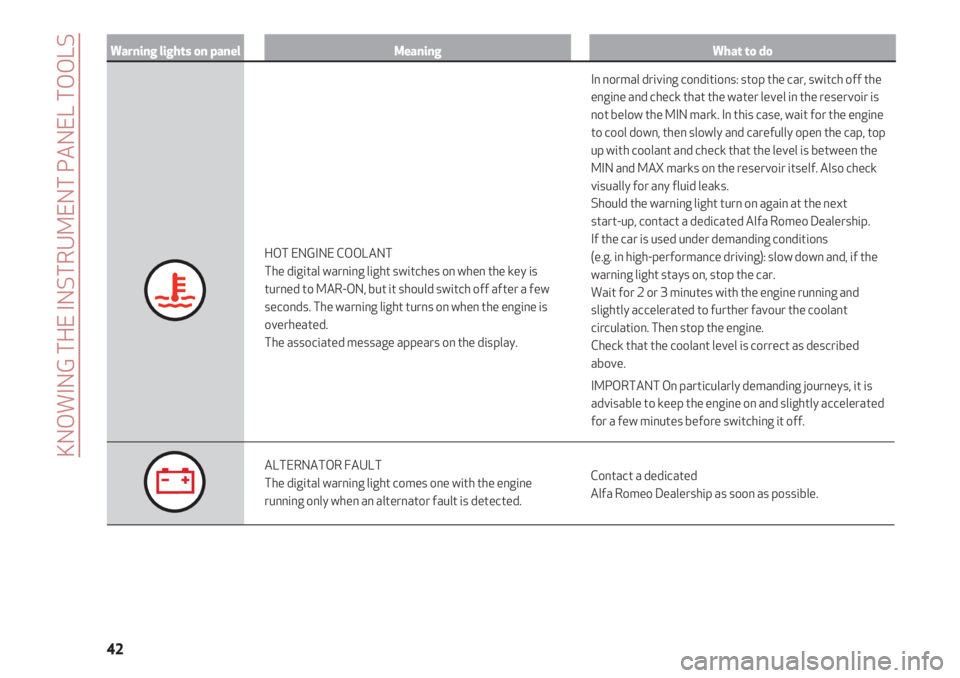
KNOWING THE INSTRUMENT PANEL TOOLS
42
Warning lights on panelMeaningWhat to do
HOT ENGINE COOLANT
The digital warning light switches on when the key is
turned to MAR-ON, but it should switch off after a few
seconds. The warning light turns on when the engine is
overheated.
The associated message appears on the display.
ALTERNATOR FAULT
The digital warning light comes one with the engine
running only when an alternator fault is detected.Contact a dedicated
Alfa Romeo Dealership as soon as possible.
In normal driving conditions: stop the car, switch off the
engine and check that the water level in the reservoir is
not below the MIN mark. In this case, wait for the engine
to cool down, then slowly and carefully open the cap, top
up with coolant and check that the level is between the
MIN and MAX marks on the reservoir itself. Also check
visually for any fluid leaks.
Should the warning light turn on again at the next
start-up, contact a dedicated Alfa Romeo Dealership.
If the car is used under demanding conditions
(e.g. in high-performance driving): slow down and, if the
warning light stays on, stop the car.
Wait for 2 or 3 minutes with the engine running and
slightly accelerated to further favour the coolant
circulation. Then stop the engine.
Check that the coolant level is correct as described
above.
IMPORTANT On particularly demanding journeys, it is
advisable to keep the engine on and slightly accelerated
for a few minutes before switching it off.
Page 45 of 156
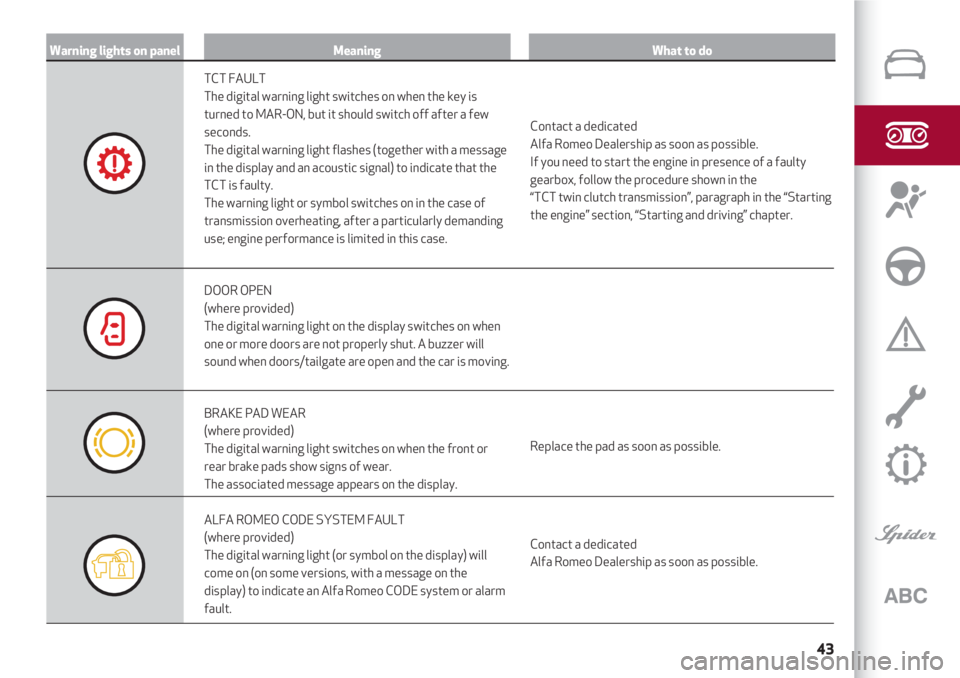
43
Warning lights on panelMeaningWhat to do
TCT FAULT
The digital warning light switches on when the key is
turned to MAR-ON, but it should switch off after a few
seconds.
The digital warning light flashes (together with a message
in the display and an acoustic signal) to indicate that the
TCT is faulty.
The warning light or symbol switches on in the case of
transmission overheating, after a particularly demanding
use; engine performance is limited in this case.
DOOR OPEN
(where provided)
The digital warning light on the display switches on when
one or more doors are not properly shut. A buzzer will
sound when doors/tailgate are open and the car is moving.
BRAKE PAD WEAR
(where provided)
The digital warning light switches on when the front or
rear brake pads show signs of wear.
The associated message appears on the display.Replace the pad as soon as possible.
ALFA ROMEO CODE SYSTEM FAULT
(where provided)
The digital warning light (or symbol on the display) will
come on (on some versions, with a message on the
display) to indicate an Alfa Romeo CODE system or alarm
fault.Contact a dedicated
Alfa Romeo Dealership as soon as possible.
Contact a dedicated
Alfa Romeo Dealership as soon as possible.
If you need to start the engine in presence of a faulty
gearbox, follow the procedure shown in the
“TCT twin clutch transmission”, paragraph in the “Starting
the engine” section, “Starting and driving” chapter.
Page 46 of 156
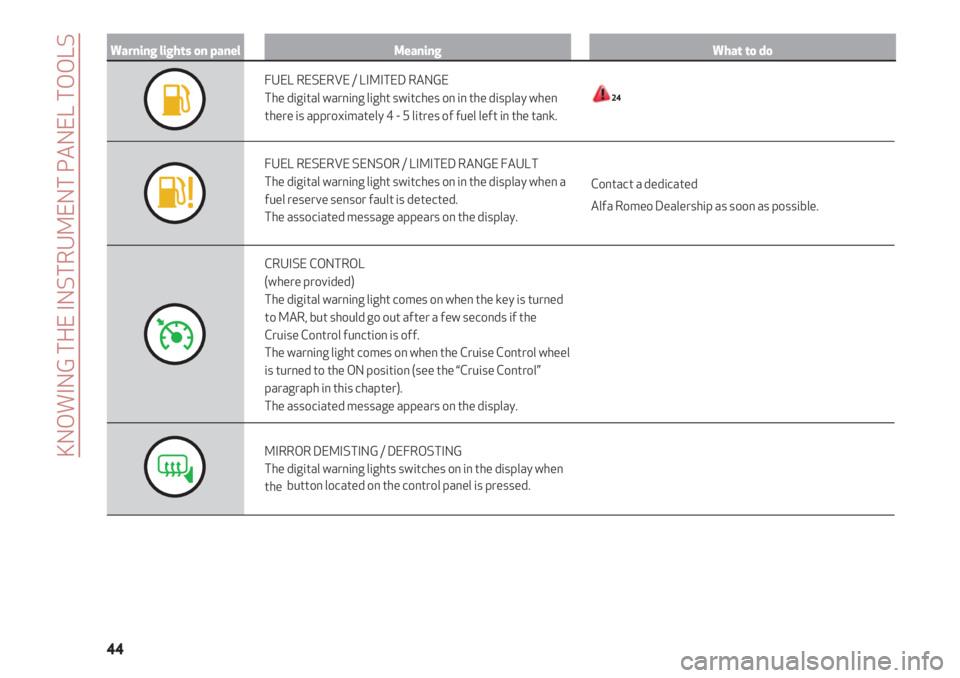
KNOWING THE INSTRUMENT PANEL TOOLS
44
Warning lights on panelMeaningWhat to do
FUEL RESERVE / LIMITED RANGE
The digital warning light switches on in the display when
there is approximately 4 - 5 litres of fuel left in the tank.
FUEL RESERVE SENSOR / LIMITED RANGE FAULT
The digital warning light switches on in the display when a
fuel reserve sensor fault is detected.
The associated message appears on the display.
CRUISE CONTROL
(where provided)
The digital warning light comes on when the key is turned
to MAR, but should go out after a few seconds if the
Cruise Control function is off.
The warning light comes on when the Cruise Control wheel
is turned to the ON position (see the “Cruise Control”
paragraph in this chapter).
The associated message appears on the display.
MIRROR DEMISTING / DEFROSTING
The digital warning lights switches on in the display when
the button located on the control panel is pressed.
Contact a dedicated
Alfa Romeo Dealership as soon as possible.
24
Page 47 of 156
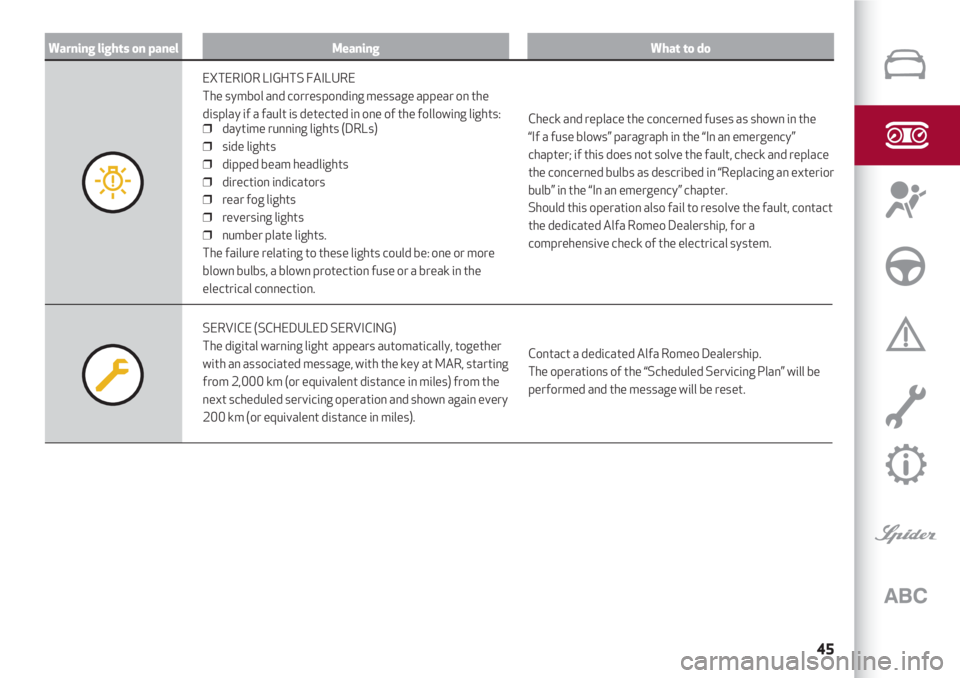
45
Warning lights on panelMeaningWhat to do
EXTERIOR LIGHTS FAILURE
The symbol and corresponding message appear on the
display if a fault is detected in one of the following lights:
❒ daytime running lights (DRLs)
❒ side lights
❒ dipped beam headlights
❒ direction indicators
❒ rear fog lights
❒ reversing lights
❒ number plate lights.
The failure relating to these lights could be: one or more
blown bulbs, a blown protection fuse or a break in the
electrical connection.
Check and replace the concerned fuses as shown in the
“If a fuse blows” paragraph in the “In an emergency”
chapter; if this does not solve the fault, check and replace
the concerned bulbs as described in “Replacing an exterior
bulb” in the “In an emergency” chapter.
Should this operation also fail to resolve the fault, contact
the dedicated Alfa Romeo Dealership, for a
comprehensive check of the electrical system.
SERVICE (SCHEDULED SERVICING)
The digital warning light appears automatically, together
with an associated message, with the key at MAR, starting
from 2,000 km (or equivalent distance in miles) from the
next scheduled servicing operation and shown again every
200 km (or equivalent distance in miles).Contact a dedicated Alfa Romeo Dealership.
The operations of the “Scheduled Servicing Plan” will be
performed and the message will be reset.
Page 50 of 156
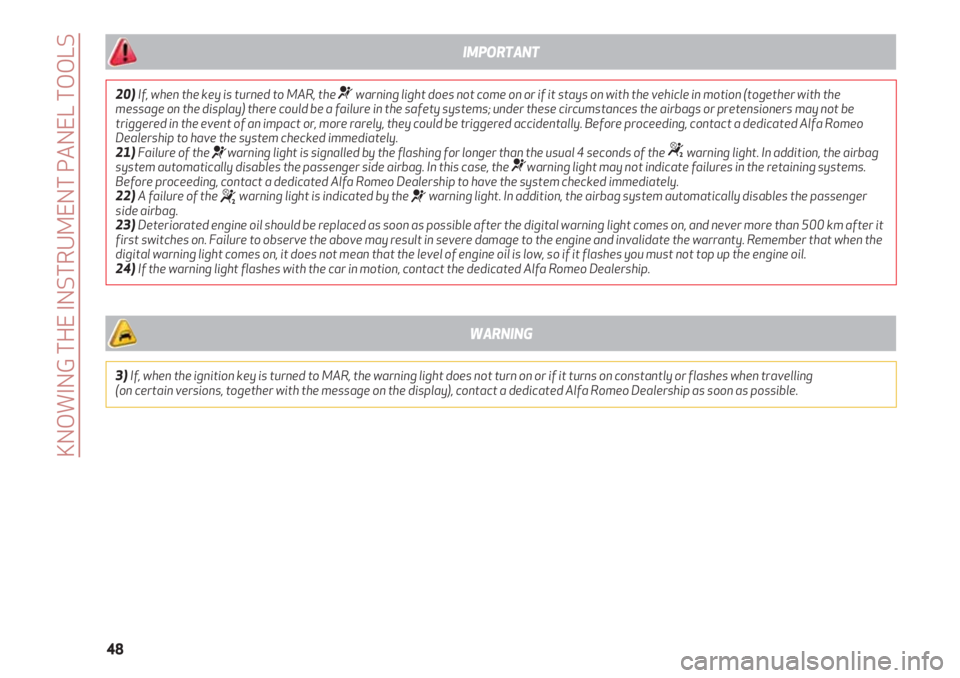
KNOWING THE INSTRUMENT PANEL TOOLS
48
20)If, when the key is turned to MAR, the ¬warning light does not come on or if it stays on with the vehicle in motion (together with the
message on the display) there could be a failure in the safety systems; under these circumstances the airbags or pretensioners may not be
triggered in the event of an impact or, more rarely, they could be triggered accidentally. Before proceeding, contact a dedicated Alfa Romeo
Dealership to have the system checked immediately.
21)Failure of the
¬warning light is signalled by the flashing for longer than the usual 4 seconds of the “warning light. In addition, the airbag
system automatically disables the passenger side airbag. In this case, the ¬warning light may not indicate failures in the retaining systems.
Before proceeding, contact a dedicated Alfa Romeo Dealership to have the system checked immediately.
22)A failure of the
“warning light is indicated by the ¬warning light. In addition, the airbag system automatically disables the passenger
side airbag.
23)Deteriorated engine oil should be replaced as soon as possible after the digital warning light comes on, and never more than 500 km after it
first switches on. Failure to observe the above may result in severe damage to the engine and invalidate the warranty. Remember that when the
digital warning light comes on, it does not mean that the level of engine oil is low, so if it flashes you must not top up the engine oil.
24)If the warning light flashes with the car in motion, contact the dedicated Alfa Romeo Dealership.
IMPORTANT
3)If, when the ignition key is turned to MAR, the warning light does not turn on or if it turns on constantly or flashes when travelling
(on certain versions, together with the message on the display), contact a dedicated Alfa Romeo Dealership as soon as possible.
WARNING
Page 68 of 156
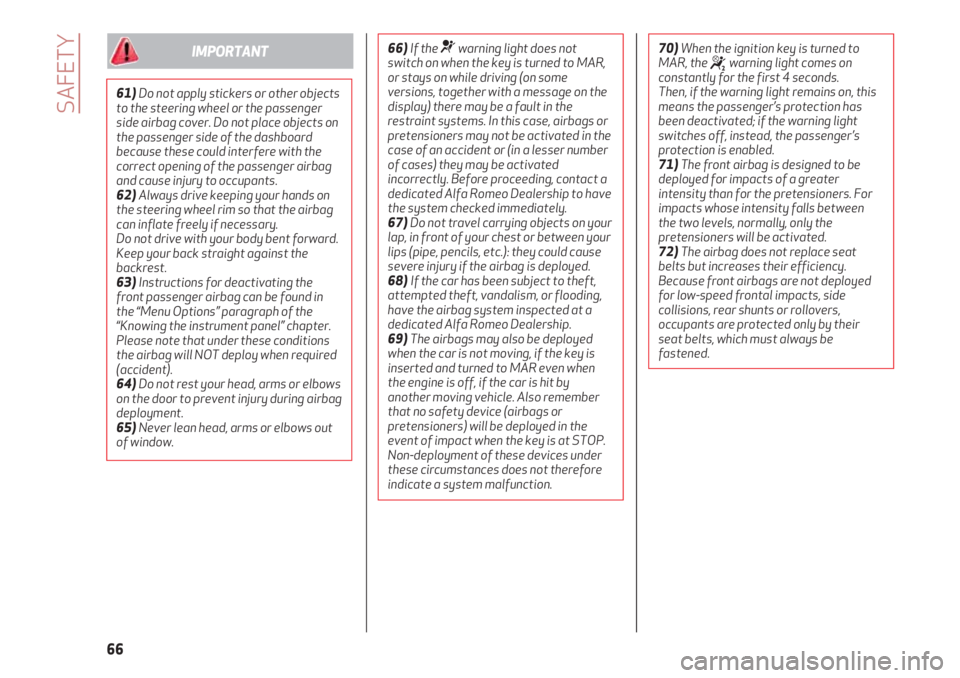
SAFETY
66
61)Do not apply stickers or other objects
to the steering wheel or the passenger
side airbag cover. Do not place objects on
the passenger side of the dashboard
because these could interfere with the
correct opening of the passenger airbag
and cause injury to occupants.
62)Always drive keeping your hands on
the steering wheel rim so that the airbag
can inflate freely if necessary.
Do not drive with your body bent forward.
Keep your back straight against the
backrest.
63)Instructions for deactivating the
front passenger airbag can be found in
the “Menu Options” paragraph of the
“Knowing the instrument panel” chapter.
Please note that under these conditions
the airbag will NOT deploy when required
(accident).
64)Do not rest your head, arms or elbows
on the door to prevent injury during airbag
deployment.
65)Never lean head, arms or elbows out
of window.
IMPORTANT66)If the ¬warning light does not
switch on when the key is turned to MAR,
or stays on while driving (on some
versions, together with a message on the
display) there may be a fault in the
restraint systems. In this case, airbags or
pretensioners may not be activated in the
case of an accident or (in a lesser number
of cases) they may be activated
incorrectly. Before proceeding, contact a
dedicated Alfa Romeo Dealership to have
the system checked immediately.
67)Do not travel carrying objects on your
lap, in front of your chest or between your
lips (pipe, pencils, etc.): they could cause
severe injury if the airbag is deployed.
68) If the car has been subject to theft,
attempted theft, vandalism, or flooding,
have the airbag system inspected at a
dedicated Alfa Romeo Dealership.
69)The airbags may also be deployed
when the car is not moving, if the key is
inserted and turned to MAR even when
the engine is off, if the car is hit by
another moving vehicle. Also remember
that no safety device (airbags or
pretensioners) will be deployed in the
event of impact when the key is at STOP.
Non-deployment of these devices under
these circumstances does not therefore
indicate a system malfunction.70)When the ignition key is turned to
MAR, the
“warning light comes on
constantly for the first 4 seconds.
Then, if the warning light remains on, this
means the passenger’s protection has
been deactivated; if the warning light
switches off, instead, the passenger’s
protection is enabled.
71)The front airbag is designed to be
deployed for impacts of a greater
intensity than for the pretensioners. For
impacts whose intensity falls between
the two levels, normally, only the
pretensioners will be activated.
72)The airbag does not replace seat
belts but increases their efficiency.
Because front airbags are not deployed
for low-speed frontal impacts, side
collisions, rear shunts or rollovers,
occupants are protected only by their
seat belts, which must always be
fastened.
Page 70 of 156
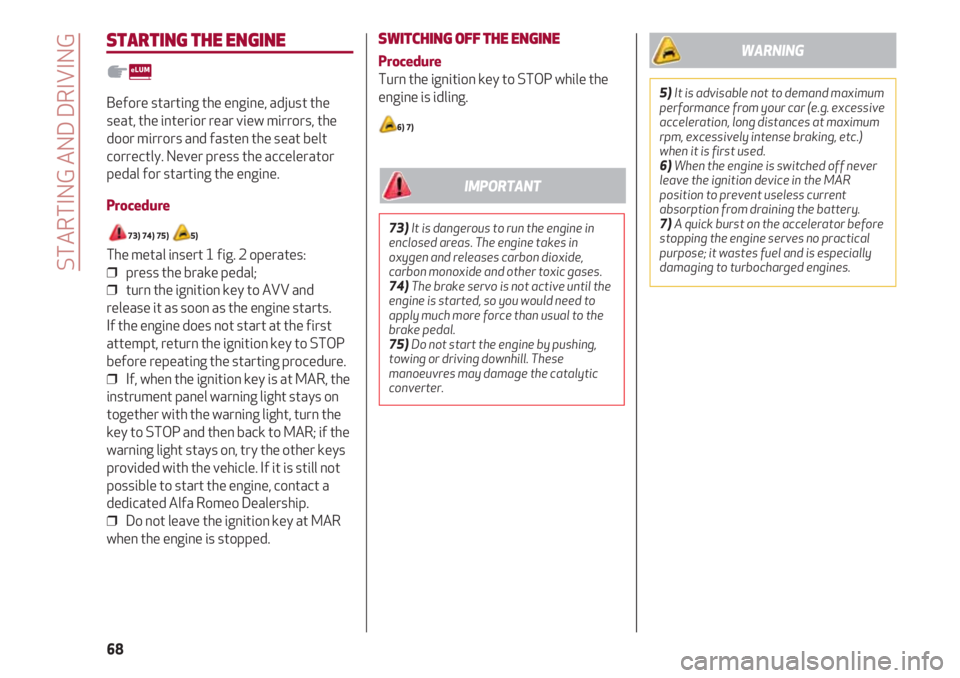
STARTING AND DRIVING
68
STARTING THE ENGINE
Before starting the engine, adjust the
seat, the interior rear view mirrors, the
door mirrors and fasten the seat belt
correctly. Never press the accelerator
pedal for starting the engine.
Procedure
73) 74) 75) 5)
The metal insert 1 fig. 2 operates:
❒ press the brake pedal;
❒ turn the ignition key to AVV and
release it as soon as the engine starts.
If the engine does not start at the first
attempt, return the ignition key to STOP
before repeating the starting procedure.
❒ If, when the ignition key is at MAR, the
instrument panel warning light stays on
together with the warning light, turn the
key to STOP and then back to MAR; if the
warning light stays on, try the other keys
provided with the vehicle. If it is still not
possible to start the engine, contact a
dedicated Alfa Romeo Dealership.
❒ Do not leave the ignition key at MAR
when the engine is stopped.
SWITCHING OFF THE ENGINE
Procedure
Turn the ignition key to STOP while the
engine is idling.
6) 7)
73)It is dangerous to run the engine in
enclosed areas. The engine takes in
oxygen and releases carbon dioxide,
carbon monoxide and other toxic gases.
74)The brake servo is not active until the
engine is started, so you would need to
apply much more force than usual to the
brake pedal.
75)Do not start the engine by pushing,
towing or driving downhill. These
manoeuvres may damage the catalytic
converter.
IMPORTANT
5)It is advisable not to demand maximum
performance from your car (e.g. excessive
acceleration, long distances at maximum
rpm, excessively intense braking, etc.)
when it is first used.
6)When the engine is switched off never
leave the ignition device in the MAR
position to prevent useless current
absorption from draining the battery.
7)A quick burst on the accelerator before
stopping the engine serves no practical
purpose; it wastes fuel and is especially
damaging to turbocharged engines.
WARNING
Page 71 of 156
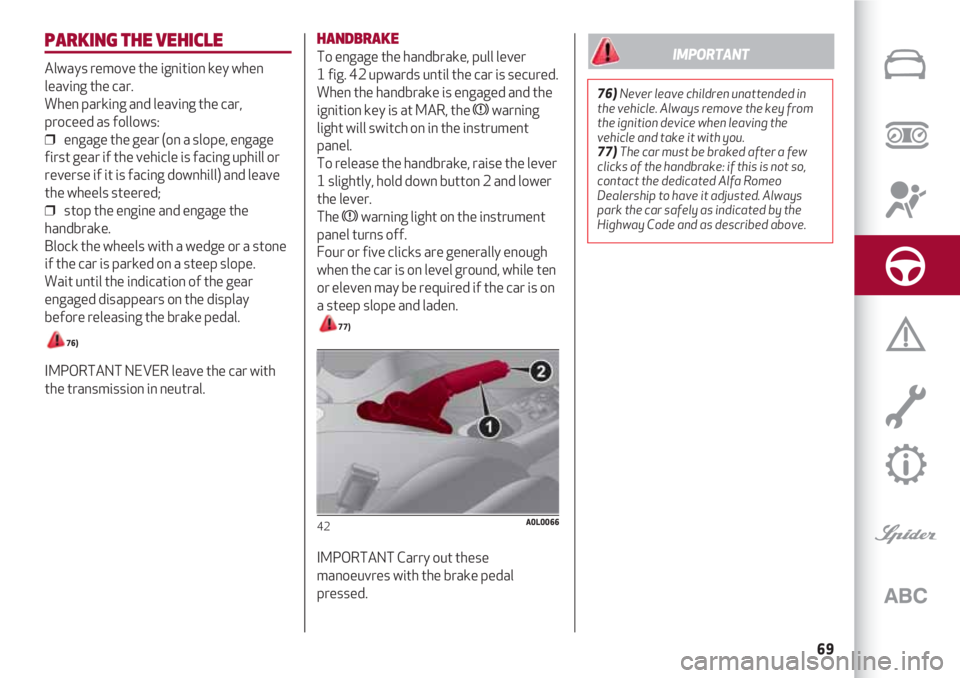
69
PARKING THE VEHICLE
Always remove the ignition key when
leaving the car.
When parking and leaving the car,
proceed as follows:
❒ engage the gear (on a slope, engage
first gear if the vehicle is facing uphill or
reverse if it is facing downhill) and leave
the wheels steered;
❒ stop the engine and engage the
handbrake.
Block the wheels with a wedge or a stone
if the car is parked on a steep slope.
Wait until the indication of the gear
engaged disappears on the display
before releasing the brake pedal.
76)
IMPORTANT NEVER leave the car with
the transmission in neutral.
HANDBRAKE
To engage the handbrake, pull lever
1 fig. 42 upwards until the car is secured.
When the handbrake is engaged and the
ignition key is at MAR, the xwarning
light will switch on in the instrument
panel.
To release the handbrake, raise the lever
1 slightly, hold down button 2 and lower
the lever.
The xwarning light on the instrument
panel turns off.
Four or five clicks are generally enough
when the car is on level ground, while ten
or eleven may be required if the car is on
a steep slope and laden.
77)
IMPORTANT Carry out these
manoeuvres with the brake pedal
pressed.
42A0L0066
76)Never leave children unattended in
the vehicle. Always remove the key from
the ignition device when leaving the
vehicle and take it with you.
77)The car must be braked after a few
clicks of the handbrake: if this is not so,
contact the dedicated Alfa Romeo
Dealership to have it adjusted. Always
park the car safely as indicated by the
Highway Code and as described above.
IMPORTANT
Page 72 of 156
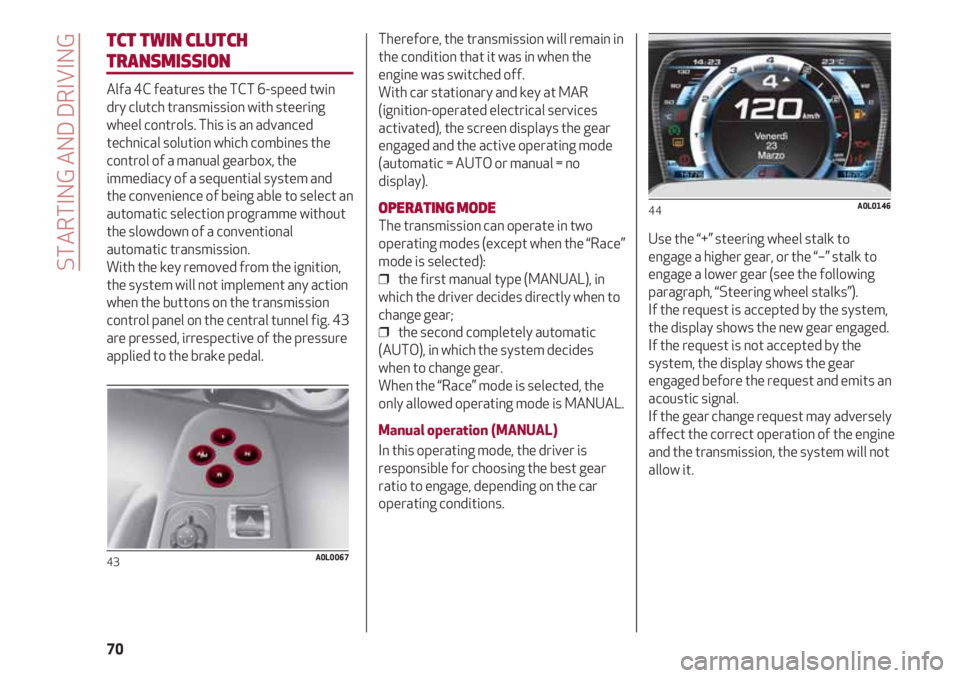
STARTING AND DRIVING
70
TCT TWIN CLUTCH
TRANSMISSION
Alfa 4C features the TCT 6-speed twin
dry clutch transmission with steering
wheel controls. This is an advanced
technical solution which combines the
control of a manual gearbox, the
immediacy of a sequential system and
the convenience of being able to select an
automatic selection programme without
the slowdown of a conventional
automatic transmission.
With the key removed from the ignition,
the system will not implement any action
when the buttons on the transmission
control panel on the central tunnel fig. 43
are pressed, irrespective of the pressure
applied to the brake pedal.
43A0L0067
Therefore, the transmission will remain in
the condition that it was in when the
engine was switched off.
With car stationary and key at MAR
(ignition-operated electrical services
activated), the screen displays the gear
engaged and the active operating mode
(automatic = AUTO or manual = no
display).
OPERATING MODE
The transmission can operate in two
operating modes (except when the “Race”
mode is selected):
❒ the first manual type (MANUAL), in
which the driver decides directly when to
change gear;
❒ the second completely automatic
(AUTO), in which the system decides
when to change gear.
When the “Race” mode is selected, the
only allowed operating mode is MANUAL.
Manual operation (MANUAL)
In this operating mode, the driver is
responsible for choosing the best gear
ratio to engage, depending on the car
operating conditions.Use the “+” steering wheel stalk to
engage a higher gear, or the “–” stalk to
engage a lower gear (see the following
paragraph, “Steering wheel stalks”).
If the request is accepted by the system,
the display shows the new gear engaged.
If the request is not accepted by the
system, the display shows the gear
engaged before the request and emits an
acoustic signal.
If the gear change request may adversely
affect the correct operation of the engine
and the transmission, the system will not
allow it.
44A0L0146
Page 74 of 156

STARTING AND DRIVING
72
The shifting up or down is only permitted
if the engine revs allow it.
STARTING THE ENGINE
To start the engine press the brake pedal:
the system engages neutral (N)
automatically.
After the starting procedure, 1st gear (1)
or reverse (R) can be engaged.
Irrespective of the mode selected
(AUTO/MANUAL), to engage 1st gear or
reverse (R), it is necessary to press the
brake pedal and press the 1 button on the
transmission control panel (or the “+”
steering wheel stalk) to engage 1st gear
or the R button to engage reverse.
When 1st gear is engaged, the system
sets itself to AUTO mode.
Neutral (N) can be engaged again by
pressing the N button with the brake
pedal pressed.
When the 1, N or R buttons are pressed
(or “+” steering wheel stalk is operated)
without pressing the brake pedal, no gear
change request is implemented by the
system.
IMPORTANT Reverse cannot be engaged
by pressing the “-” stalk on the steering
wheel.
Important notes
To start in presence of a gearbox fault
(see “Warning lights and messages”
paragraph in the “Knowing the instrument
panel” chapter), run the
“Delayed start-up” procedure:
turn the key to the AVV position for at
least 7 seconds with the brake depressed
and the engine will start.
The system will remain in “recovery”
condition.
If the engine does not start, contact a
dedicated Alfa Romeo Dealership.
When the driver’s door is opened, the
system activates the hydraulic
components so that they are prepared
for the subsequent engine starting.
MOVING THE CAR
The car can set off both in 1st gear and
reverse (R).
The gears can only be engaged by
pressing the brake pedal. If the brake
pedal is not depressed, the display will
show a dedicated message.It is not possible to set off in a higher gear
than 1st: if this is attempted, the display
shows a dedicated message.
When setting off on a medium-steep
incline, it is advisable to engage the
handbrake.
Engaging 1st gear
Proceed as follows:
❒ press the brake pedal;
❒ press the 1 button on the
transmission control panel;
❒ release the brake pedal and press the
accelerator pedal.
Engaging reverse (R)
Reverse (R) can only be engaged with car
stationary and brake pedal pressed.
Proceed as follows:
❒ press the brake pedal (car completely
stationary);
❒ press button R on the
gearbox panel;
❒ release the brake pedal and press the
accelerator pedal.
When reverse is engaged on some
versions, the system emits an acoustic
signal.
If the brake pedal is not depressed (and
the vehicle is stationary), the display will
show a dedicated message and the
system will automatically engage neutral
(N).